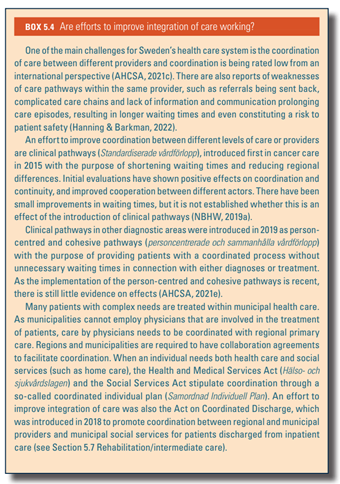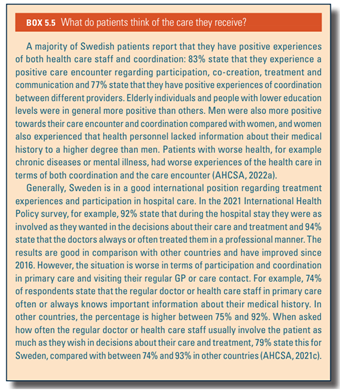-
22 April 2024 | Country Update
A new national care plan for maternity care – an important investment in women's health
5.4. Specialized care4
In 2021, approximately 4.2 million patients received care within specialized inpatient or outpatient care (NBHW, 2022d). Out of the approximately 1.5 million patients that had a surgical procedure in 2021, about 27% underwent the surgery within inpatient care (NBHW, 2022d).
Specialized somatic care involves health and medical services requiring medical equipment or other technologies that cannot be provided in the primary care setting. Services are divided into two areas: outpatient (ambulatory and day care) and inpatient care. Structural changes in specialized care during the past decades have focused on a shift from hospital inpatient care towards outpatient care and day care, and concentration of highly specialized care and an emphasis on separating emergency care from elective care. During the 1990s, the development towards day surgery gained momentum, which was followed by increased specialization of smaller hospitals (orthopaedic centres, rehabilitation centres or limited emergency intake) and concentration into 24/7 emergency hospitals at the end of the decade. After that, there has been a gradual concentration of supply to larger hospitals at the regional level, particularly in the 2010s and later on also at the national level. The formation of regional cancer centres (see section 2.3 Decentralization and centralization) in the same decade supported further concentration of services. Since 2018, national highly specialized care (formerly referred to as Rikssjukvård) is regulated to be performed at a maximum of five hospitals (and their adjoining units). The aim is to ensure the highest possible quality in the event of rare and advanced care requiring special competence or facilities. A special board at NBHW decides on which hospitals receive permission to provide such care, including special conditions for the permission. National highly specialized care is estimated to respond to about 4 – 5% of the produced volume in inpatient care (Government Bill, 2017/18:40).
Authors
References
5.4.1. Specialized ambulatory care
In 2021, 2052 consultations per 1000 inhabitants were made in specialized somatic care, and 606 in psychiatric specialized care (SALAR, 2022f). About 22% of the consultations were privately provided, although with public financing.
A large part of specialized ambulatory care (outpatient care) consists of consultations or day surgery. However, the shift from inpatient to outpatient settings as well as the development of medical technology has also led to an increase in hospital-related home health care as a complement to inpatient care in some regions. Such hospital-related home health care can be provided 24/7, contains qualified medical technology and may require a hospital bed to be available in the event that the patient needs it (SOU, 2019:29).
5.4.2. Day care
Day care includes day surgery and other day treatments and diagnostic procedures such as day endoscopy. In 2021, approximately 2.1 million day-care episodes were provided in Sweden (SALAR, 2022f).
An increasing number of surgical procedures are performed as day surgery. In 2020, there were about 640 000 day-surgical care episodes, constituting about 6% of outpatient specialized care (NBHW, 2022e). There is an average of 2.1 day-surgery cases to every surgical care episode in inpatient care. There are however large variations in day-surgery rates across regions; between 2.8 and 0.9 (NBHW, 2022e). The most common procedures within day surgery are skin procedures and cataract surgery, which is almost exclusively performed within day care. Within hand and wrist treatment, almost 90% was performed in day care and the share of day-care surgery of tonsillectomy was about 85% (NBHW, 2022e).
5.4.3. Inpatient care
In 2021, approximately 1 385 000 admissions took place in Swedish hospitals, but the number of episodes has been decreasing steadily since 2013 (NBHW, 2022d). The most common reason for admission to hospital was cardiovascular diseases and symptom diagnoses, such as stomach and chest pains. For women, injuries and poisonings were about as common as cardiovascular diseases, but the dominant reason was childbirth.
The average care episode varies between 3.2 and 4.7 days in the regions. However, this is not necessarily a sign of a potential to improve efficiency because the variations may be explained by differences in reporting. The data on average care episodes exclude geriatric and psychiatric care, but some regions include geriatric care within the hospital’s medical clinics, whereas others have specific geriatric clinics excluded from the definition of inpatient care. In 2021, 405 000 patients had surgery in inpatient care (NBHW, 2022d). Apart from minor surgical interventions, operations on the musculoskeletal system (for example, hip joints and thighs) were the most common surgery category in inpatient care.
In 2019, there were 190 hospital beds per 100 000 inhabitants, a decrease of 39% since 2000 (see section 4.1 Physical resources). Although part of the decrease in hospital beds can be explained by medical/technical innovations, enabling an increase in minimally invasive surgery, day-care surgery and outpatient treatments, it cannot account for the entire decrease. Overcrowding and relocations (patients treated at a unit other than the one that has specific competence and medical responsibility for the patient) per 100 hospital beds has increased from 4% in 2014 to 7% in 2021, indicating that the available number of hospital beds is not optimal. There are however large variations between regions, varying between 2% and 19% (NBHW, 2022f).
In 2022, there were 66 emergency hospitals where care was offered 24/7. These hospitals differ in terms of scope (assignment, services), scale (number of staff and beds) and catchment area (population served). The precise number of hospitals depends on the definition, for example, if specialized clinics without emergency units are included and if large hospitals with separate facilities in nearby cities count as one or two hospitals. Smaller county hospitals (Länsdelssjukhus) with 12 or 13 medical specialties and county hospitals (Länssjukhus) with about 20+ medical specialties exist in all 21 regions (AHCSA, 2018b). Regional hospitals with 40+ medical specialties are responsible for more advanced acute and planned care and a larger catchment area. Regional hospitals are also university hospitals with extensive teaching and research responsibilities. There are seven regional/university hospitals situated in the six collaborative health care regions (see also section 2.2 Organization). All regional/university hospitals have advanced medical equipment and offer highly specialized care, in order to facilitate cooperation regarding tertiary medical care and to maintain a high level of advanced medical care and clinical competence. The latter is achieved by pooling patients with rare diseases or severe conditions to a few hospitals, instead of treating a small number of these patients at several hospitals. The regions that do not have their own regional hospital have agreements with neighbouring regions that can receive patients for the highly specialized care.
Box5.4 assesses efforts to improve the integration of care in Sweden. Box5.5 provides patient evaluations of care.
| Box5.4 | Box5.5 |
 |  |
